2014 NISSAN GT-R cooling
[x] Cancel search: coolingPage 14 of 354
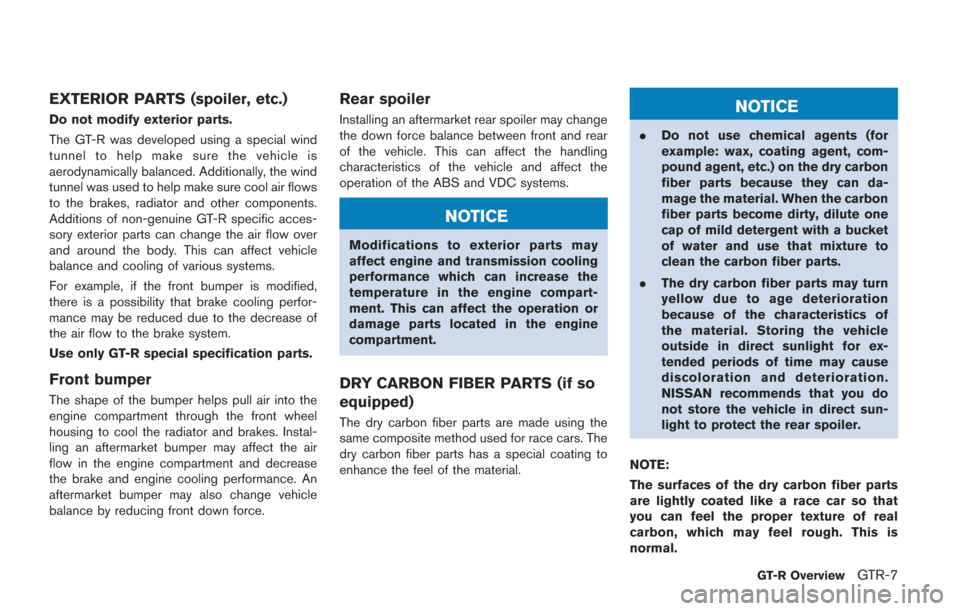
EXTERIOR PARTS (spoiler, etc.)
Do not modify exterior parts.
The GT-R was developed using a special wind
tunnel to help make sure the vehicle is
aerodynamically balanced. Additionally, the wind
tunnel was used to help make sure cool air flows
to the brakes, radiator and other components.
Additions of non-genuine GT-R specific acces-
sory exterior parts can change the air flow over
and around the body. This can affect vehicle
balance and cooling of various systems.
For example, if the front bumper is modified,
there is a possibility that brake cooling perfor-
mance may be reduced due to the decrease of
the air flow to the brake system.
Use only GT-R special specification parts.
Front bumper
The shape of the bumper helps pull air into the
engine compartment through the front wheel
housing to cool the radiator and brakes. Instal-
ling an aftermarket bumper may affect the air
flow in the engine compartment and decrease
the brake and engine cooling performance. An
aftermarket bumper may also change vehicle
balance by reducing front down force.
Rear spoiler
Installing an aftermarket rear spoiler may change
the down force balance between front and rear
of the vehicle. This can affect the handling
characteristics of the vehicle and affect the
operation of the ABS and VDC systems.
NOTICE
Modifications to exterior parts may
affect engine and transmission cooling
performance which can increase the
temperature in the engine compart-
ment. This can affect the operation or
damage parts located in the engine
compartment.
DRY CARBON FIBER PARTS (if so
equipped)
The dry carbon fiber parts are made using the
same composite method used for race cars. The
dry carbon fiber parts has a special coating to
enhance the feel of the material.
NOTICE
.Do not use chemical agents (for
example: wax, coating agent, com-
pound agent, etc.) on the dry carbon
fiber parts because they can da-
mage the material. When the carbon
fiber parts become dirty, dilute one
cap of mild detergent with a bucket
of water and use that mixture to
clean the carbon fiber parts.
. The dry carbon fiber parts may turn
yellow due to age deterioration
because of the characteristics of
the material. Storing the vehicle
outside in direct sunlight for ex-
tended periods of time may cause
discoloration and deterioration.
NISSAN recommends that you do
not store the vehicle in direct sun-
light to protect the rear spoiler.
NOTE:
The surfaces of the dry carbon fiber parts
are lightly coated like a race car so that
you can feel the proper texture of real
carbon, which may feel rough. This is
normal.
GT-R OverviewGTR-7
Page 22 of 354
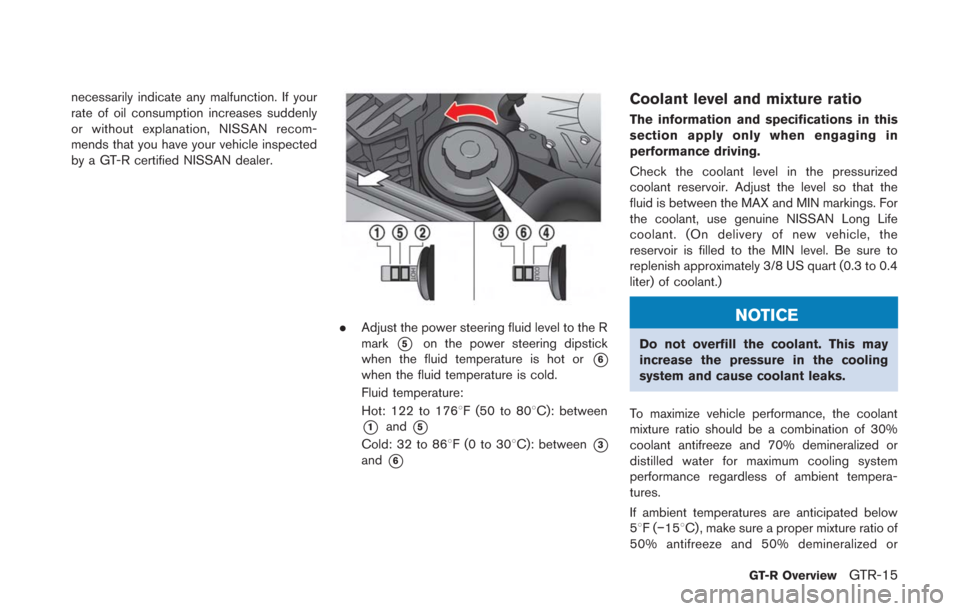
necessarily indicate any malfunction. If your
rate of oil consumption increases suddenly
or without explanation, NISSAN recom-
mends that you have your vehicle inspected
by a GT-R certified NISSAN dealer.
.Adjust the power steering fluid level to the R
mark
*5on the power steering dipstick
when the fluid temperature is hot or
*6
when the fluid temperature is cold.
Fluid temperature:
Hot: 122 to 1768F (50 to 808C): between
*1and*5
Cold: 32 to 868F(0to30 8C): between*3
and*6
Coolant level and mixture ratio
The information and specifications in this
section apply only when engaging in
performance driving.
Check the coolant level in the pressurized
coolant reservoir. Adjust the level so that the
fluid is between the MAX and MIN markings. For
the coolant, use genuine NISSAN Long Life
coolant. (On delivery of new vehicle, the
reservoir is filled to the MIN level. Be sure to
replenish approximately 3/8 US quart (0.3 to 0.4
liter) of coolant.)
NOTICE
Do not overfill the coolant. This may
increase the pressure in the cooling
system and cause coolant leaks.
To maximize vehicle performance, the coolant
mixture ratio should be a combination of 30%
coolant antifreeze and 70% demineralized or
distilled water for maximum cooling system
performance regardless of ambient tempera-
tures.
If ambient temperatures are anticipated below
58F( −158C) , make sure a proper mixture ratio of
50% antifreeze and 50% demineralized or
GT-R OverviewGTR-15
Page 211 of 354
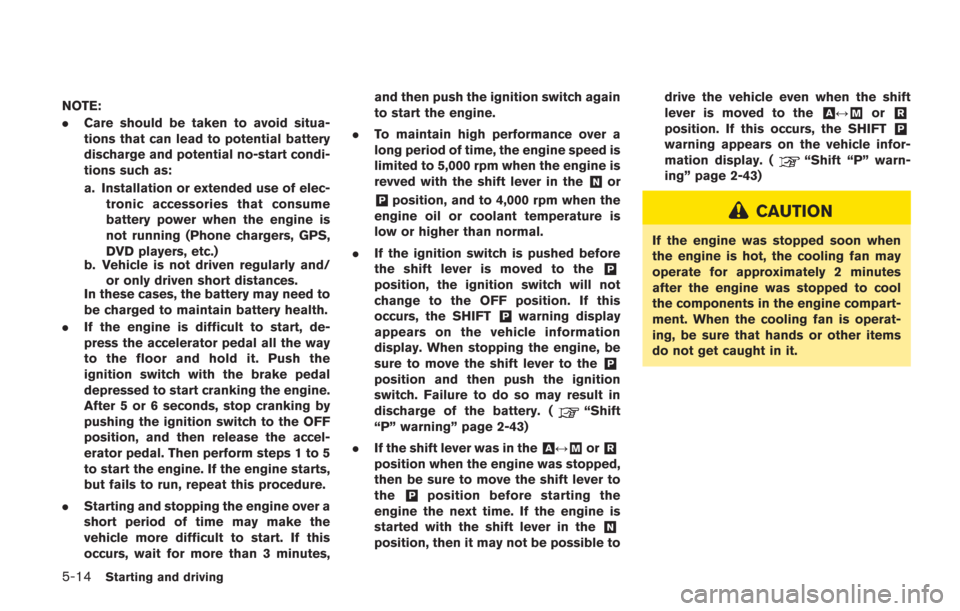
5-14Starting and driving
NOTE:
.Care should be taken to avoid situa-
tions that can lead to potential battery
discharge and potential no-start condi-
tions such as:
a. Installation or extended use of elec-
tronic accessories that consume
battery power when the engine is
not running (Phone chargers, GPS,
DVD players, etc.)
b. Vehicle is not driven regularly and/
or only driven short distances.
In these cases, the battery may need to
be charged to maintain battery health.
. If the engine is difficult to start, de-
press the accelerator pedal all the way
to the floor and hold it. Push the
ignition switch with the brake pedal
depressed to start cranking the engine.
After 5 or 6 seconds, stop cranking by
pushing the ignition switch to the OFF
position, and then release the accel-
erator pedal. Then perform steps 1 to 5
to start the engine. If the engine starts,
but fails to run, repeat this procedure.
. Starting and stopping the engine over a
short period of time may make the
vehicle more difficult to start. If this
occurs, wait for more than 3 minutes, and then push the ignition switch again
to start the engine.
. To maintain high performance over a
long period of time, the engine speed is
limited to 5,000 rpm when the engine is
revved with the shift lever in the
&Nor
&Pposition, and to 4,000 rpm when the
engine oil or coolant temperature is
low or higher than normal.
. If the ignition switch is pushed before
the shift lever is moved to the
&P
position, the ignition switch will not
change to the OFF position. If this
occurs, the SHIFT
&Pwarning display
appears on the vehicle information
display. When stopping the engine, be
sure to move the shift lever to the
&P
position and then push the ignition
switch. Failure to do so may result in
discharge of the battery. (
“Shift
“P” warning” page 2-43)
. If the shift lever was in the
&A↔&Mor&R
position when the engine was stopped,
then be sure to move the shift lever to
the
&Pposition before starting the
engine the next time. If the engine is
started with the shift lever in the
&N
position, then it may not be possible to drive the vehicle even when the shift
lever is moved to the
&A↔&Mor&R
position. If this occurs, the SHIFT&P
warning appears on the vehicle infor-
mation display. (“Shift “P” warn-
ing” page 2-43)
CAUTION
If the engine was stopped soon when
the engine is hot, the cooling fan may
operate for approximately 2 minutes
after the engine was stopped to cool
the components in the engine compart-
ment. When the cooling fan is operat-
ing, be sure that hands or other items
do not get caught in it.
Page 227 of 354
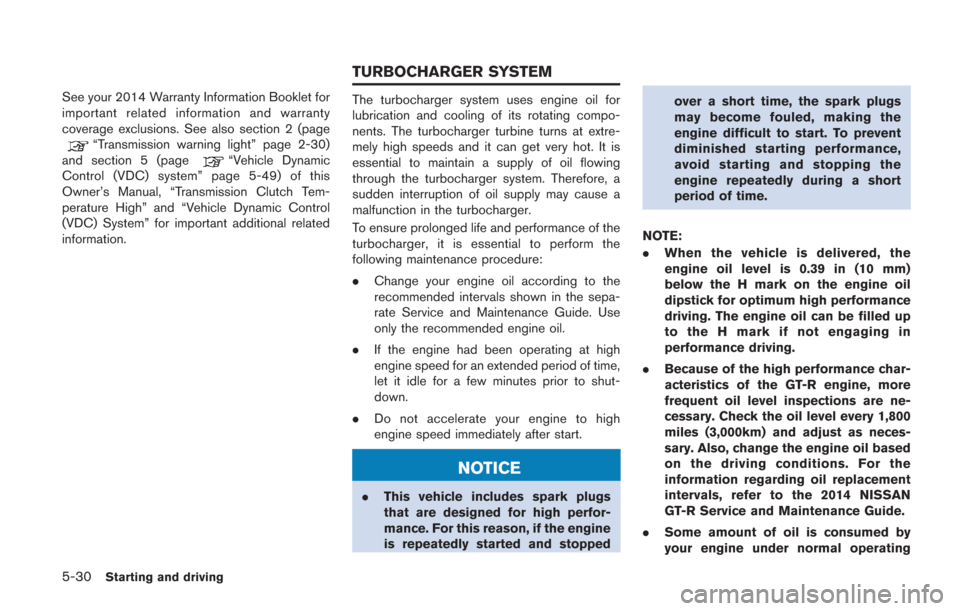
5-30Starting and driving
See your 2014 Warranty Information Booklet for
important related information and warranty
coverage exclusions. See also section 2 (page
“Transmission warning light” page 2-30)
and section 5 (page“Vehicle Dynamic
Control (VDC) system” page 5-49) of this
Owner’s Manual, “Transmission Clutch Tem-
perature High” and “Vehicle Dynamic Control
(VDC) System” for important additional related
information.
The turbocharger system uses engine oil for
lubrication and cooling of its rotating compo-
nents. The turbocharger turbine turns at extre-
mely high speeds and it can get very hot. It is
essential to maintain a supply of oil flowing
through the turbocharger system. Therefore, a
sudden interruption of oil supply may cause a
malfunction in the turbocharger.
To ensure prolonged life and performance of the
turbocharger, it is essential to perform the
following maintenance procedure:
. Change your engine oil according to the
recommended intervals shown in the sepa-
rate Service and Maintenance Guide. Use
only the recommended engine oil.
. If the engine had been operating at high
engine speed for an extended period of time,
let it idle for a few minutes prior to shut-
down.
. Do not accelerate your engine to high
engine speed immediately after start.
NOTICE
.This vehicle includes spark plugs
that are designed for high perfor-
mance. For this reason, if the engine
is repeatedly started and stopped over a short time, the spark plugs
may become fouled, making the
engine difficult to start. To prevent
diminished starting performance,
avoid starting and stopping the
engine repeatedly during a short
period of time.
NOTE:
. When the vehicle is delivered, the
engine oil level is 0.39 in (10 mm)
below the H mark on the engine oil
dipstick for optimum high performance
driving. The engine oil can be filled up
to the H mark if not engaging in
performance driving.
. Because of the high performance char-
acteristics of the GT-R engine, more
frequent oil level inspections are ne-
cessary. Check the oil level every 1,800
miles (3,000km) and adjust as neces-
sary. Also, change the engine oil based
on the driving conditions. For the
information regarding oil replacement
intervals, refer to the 2014 NISSAN
GT-R Service and Maintenance Guide.
. Some amount of oil is consumed by
your engine under normal operating
TURBOCHARGER SYSTEM
Page 236 of 354
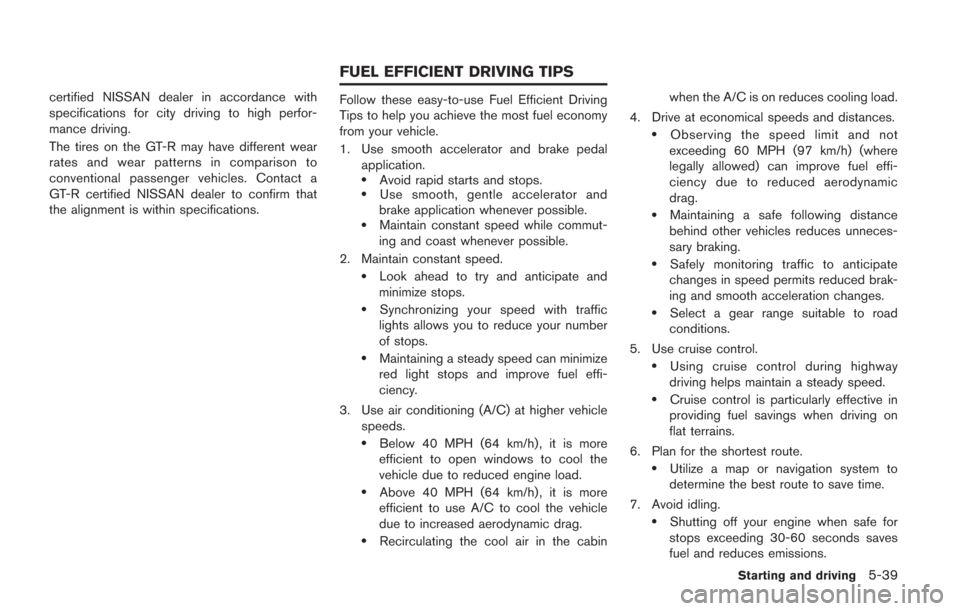
certified NISSAN dealer in accordance with
specifications for city driving to high perfor-
mance driving.
The tires on the GT-R may have different wear
rates and wear patterns in comparison to
conventional passenger vehicles. Contact a
GT-R certified NISSAN dealer to confirm that
the alignment is within specifications.Follow these easy-to-use Fuel Efficient Driving
Tips to help you achieve the most fuel economy
from your vehicle.
1. Use smooth accelerator and brake pedalapplication.
.Avoid rapid starts and stops..Use smooth, gentle accelerator and
brake application whenever possible.
.Maintain constant speed while commut-
ing and coast whenever possible.
2. Maintain constant speed.
.Look ahead to try and anticipate and
minimize stops.
.Synchronizing your speed with traffic
lights allows you to reduce your number
of stops.
.Maintaining a steady speed can minimize
red light stops and improve fuel effi-
ciency.
3. Use air conditioning (A/C) at higher vehicle speeds.
.Below 40 MPH (64 km/h), it is more
efficient to open windows to cool the
vehicle due to reduced engine load.
.Above 40 MPH (64 km/h), it is more
efficient to use A/C to cool the vehicle
due to increased aerodynamic drag.
.Recirculating the cool air in the cabin when the A/C is on reduces cooling load.
4. Drive at economical speeds and distances.
.Observing the speed limit and not
exceeding 60 MPH (97 km/h) (where
legally allowed) can improve fuel effi-
ciency due to reduced aerodynamic
drag.
.Maintaining a safe following distance
behind other vehicles reduces unneces-
sary braking.
.Safely monitoring traffic to anticipate
changes in speed permits reduced brak-
ing and smooth acceleration changes.
.Select a gear range suitable to road
conditions.
5. Use cruise control.
.Using cruise control during highway
driving helps maintain a steady speed.
.Cruise control is particularly effective in
providing fuel savings when driving on
flat terrains.
6. Plan for the shortest route.
.Utilize a map or navigation system to
determine the best route to save time.
7. Avoid idling.
.Shutting off your engine when safe for
stops exceeding 30-60 seconds saves
fuel and reduces emissions.
Starting and driving5-39
FUEL EFFICIENT DRIVING TIPS
Page 248 of 354

See your 2014 Warranty Information Booklet for
important related information and warranty
coverage exclusions. See also section 2 (page
“Transmission warning light” page 2-30)
and section 5 (page“Vehicle Dynamic
Control (VDC) system” page 5-49) of this
Owner’s Manual, “Transmission Clutch Tem-
perature High” and “Vehicle Dynamic Control
(VDC) System” for important additional related
information.
. Except for the emergency cases above,
any issues related to driving stability
(e.g., steering maneuvers and maneu-
vers during acceleration and decelera-
tion) and any damages to drivetrain
components (e.g., transfer, clutch, a
sort of gear, transaxle case) will not
be covered by warranty if there is a
record in the Vehicle Status Data
Recorder (VSDR) that the vehicle was
driven with VDC off.
. When attempting to free the vehicle
from mud or fresh snow, the VDC will
detect the tire slipping, and the engine
speed may not increase even when the
accelerator pedal is depressed. To raise
the engine speed, use the VDC set up
switch to turn the VDC system OFF and
select SAVE mode with the transmis- sion switch. (
“VDC, transmission
and suspension setup switches” page
5-24)
. When the VDC system is turned OFF,
all VDC functions (including traction
control) , except for the ABS functions,
are deactivated.FREEING A FROZEN DOOR LOCK
To prevent a door lock from freezing, apply
deicer through the key hole. If the lock becomes
frozen, heat the key before inserting it into the
key hole or use the Intelligent Key system.
ANTI-FREEZE
In the winter when it is anticipated that the
outside temperature will drop below 328F(0 8C) ,
check antifreeze to assure proper winter protec-
tion. (
“Engine cooling system” page 8-10)
BATTERY
If the battery is not fully charged during
extremely cold weather conditions, the battery
fluid may freeze and damage the battery. To
maintain maximum efficiency, the battery should
be checked regularly. (
“Battery” page 8-
17)
DRAINING OF COOLANT WATER
If the vehicle is to be left outside without
antifreeze, drain the cooling system, including
the engine block. Refill before operating the
vehicle. For details, contact a GT-R certified
NISSAN dealer.
Starting and driving5-51
COLD WEATHER DRIVING
Page 257 of 354
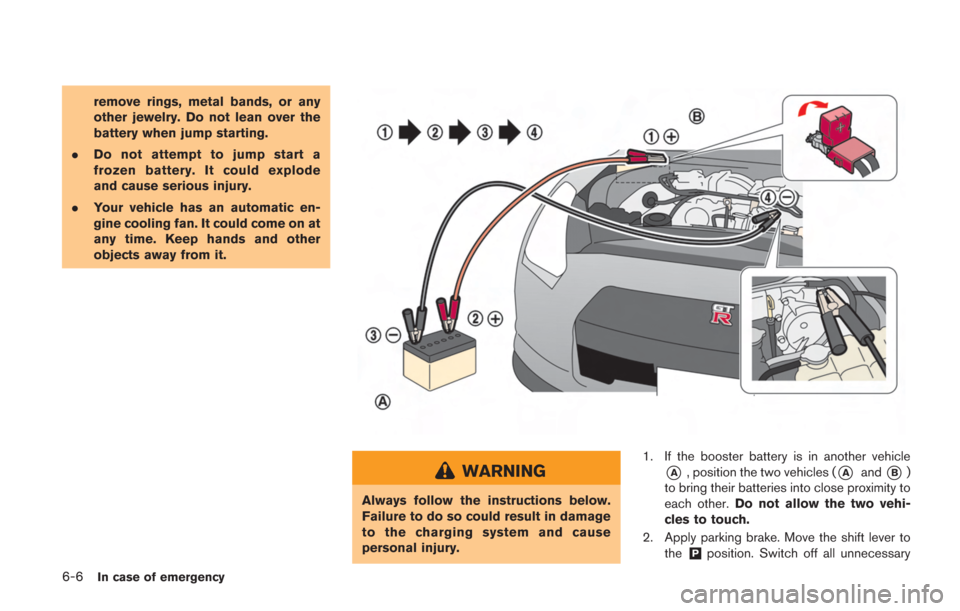
6-6In case of emergency
remove rings, metal bands, or any
other jewelry. Do not lean over the
battery when jump starting.
. Do not attempt to jump start a
frozen battery. It could explode
and cause serious injury.
. Your vehicle has an automatic en-
gine cooling fan. It could come on at
any time. Keep hands and other
objects away from it.
WARNING
Always follow the instructions below.
Failure to do so could result in damage
to the charging system and cause
personal injury. 1. If the booster battery is in another vehicle
*A, position the two vehicles (*Aand*B)
to bring their batteries into close proximity to
each other. Do not allow the two vehi-
cles to touch.
2. Apply parking brake. Move the shift lever to the
&Pposition. Switch off all unnecessary
Page 259 of 354
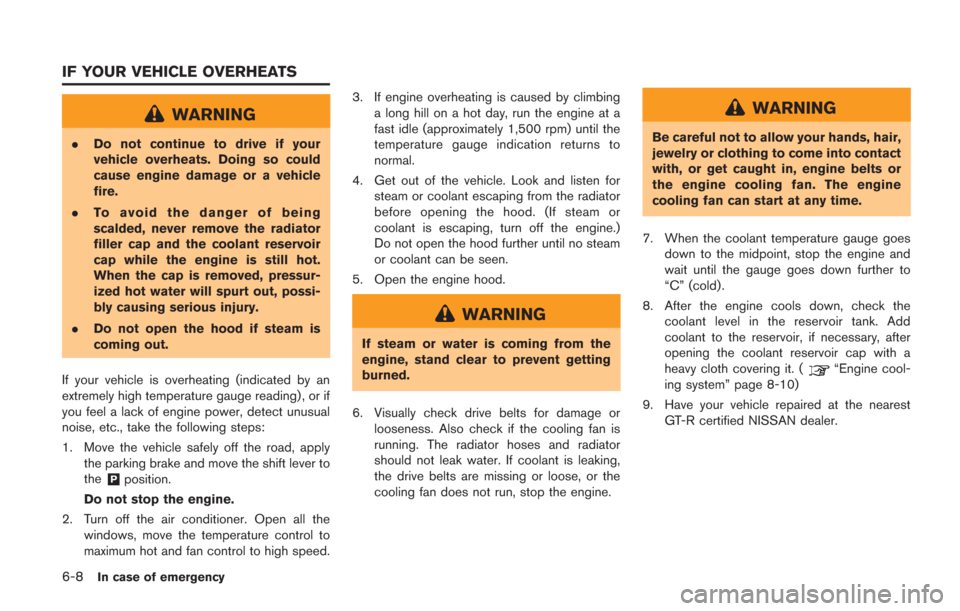
6-8In case of emergency
WARNING
.Do not continue to drive if your
vehicle overheats. Doing so could
cause engine damage or a vehicle
fire.
. To avoid the danger of being
scalded, never remove the radiator
filler cap and the coolant reservoir
cap while the engine is still hot.
When the cap is removed, pressur-
ized hot water will spurt out, possi-
bly causing serious injury.
. Do not open the hood if steam is
coming out.
If your vehicle is overheating (indicated by an
extremely high temperature gauge reading) , or if
you feel a lack of engine power, detect unusual
noise, etc., take the following steps:
1. Move the vehicle safely off the road, apply the parking brake and move the shift lever to
the
&Pposition.
Do not stop the engine.
2. Turn off the air conditioner. Open all the windows, move the temperature control to
maximum hot and fan control to high speed. 3. If engine overheating is caused by climbing
a long hill on a hot day, run the engine at a
fast idle (approximately 1,500 rpm) until the
temperature gauge indication returns to
normal.
4. Get out of the vehicle. Look and listen for steam or coolant escaping from the radiator
before opening the hood. (If steam or
coolant is escaping, turn off the engine.)
Do not open the hood further until no steam
or coolant can be seen.
5. Open the engine hood.
WARNING
If steam or water is coming from the
engine, stand clear to prevent getting
burned.
6. Visually check drive belts for damage or looseness. Also check if the cooling fan is
running. The radiator hoses and radiator
should not leak water. If coolant is leaking,
the drive belts are missing or loose, or the
cooling fan does not run, stop the engine.
WARNING
Be careful not to allow your hands, hair,
jewelry or clothing to come into contact
with, or get caught in, engine belts or
the engine cooling fan. The engine
cooling fan can start at any time.
7. When the coolant temperature gauge goes down to the midpoint, stop the engine and
wait until the gauge goes down further to
“C” (cold).
8. After the engine cools down, check the coolant level in the reservoir tank. Add
coolant to the reservoir, if necessary, after
opening the coolant reservoir cap with a
heavy cloth covering it. (
“Engine cool-
ing system” page 8-10)
9. Have your vehicle repaired at the nearest GT-R certified NISSAN dealer.
IF YOUR VEHICLE OVERHEATS